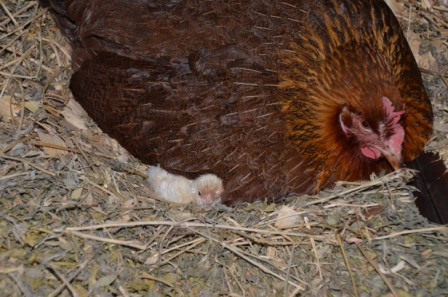So, I've been thinking about expanding the coop for some time now. I'd like to have more chickens, plus I'd like to give everyone more room to run around and do chicken stuff. I'd always imagined that my chickens would be able to free-range, but a boom in the local hawk population has made my backyard a pretty dangerous place for chickens. Here's a juvenile hawk that's been enjoying the hospitality of one of my bird baths. He was also enjoying the fish in the koi pond until we closed the sushi bar with a bit of bird netting.
With so many gardening projects on our plate, enlarging the chicken coop was a pretty low priority until recently. I came home on August 2nd and found a broody hen. If you've never experienced a broody hen before just imagine a really tough gangster chick. A broody hen ruffles her feathers until her body is twice it's normal size. The feather ruffling is accompanied by an unmistakable growling noise that unequivocally states "Back up off my nest yo!".
Broodiness isn't something you can plan for or have any control over. It's a hormonal change that occurs naturally in hens. When a hen is broody she wants to hatch eggs and poor Pansy really wanted to hatch some eggs. Since we don't have a rooster, none of our eggs are fertile. Fortunately, Laura of Wills Family Acres, volunteered to share some fertilized eggs with me so Pansy could be a mom.
Here are Pansy's 5 fertilized Brahma eggs, which we picked up on August 7th. The eggs are marked with a black line to differentiate them from other eggs that might be laid in the communal nest boxes that chickens share.
Now that a sudden, unplanned flock expansion was staring me in the face, I decided I better shake a tail feather and get started on plans to enlarge the coop. In the pictures below, the coop addition has been framed out by my hard working husband. The plan is to have a 12 X 24 foot fenced enclosure at the back of the existing coop structure. Within the 12 X 24 foot enclosure, there will be a second smaller coop, which will be used as a brooding/grow out pen. This will give the babies a safe place to grow.
 |
| Side View of Addition |
 |
| Rear View of Addition |
 |
| View from inside the current coop. |
A few hours later Mushi was joined by another Buff Bramha chick which we named Arigato. A third chick born on Saturday night died the next day, and the remaining 2 eggs were unceremoniously booted out of the nest by Pansy on Sunday afternoon.
Mushi and Arigato became fast friends. It was easy to get pictures of them together, because they seem to enjoy each other's company and warmth. Plus, when you sleep standing up, I guess you need someone to lean against.
Late on Saturday, we headed in to Callahan's to purchase 4 more chicks. We purchased 2 Dominiques and 2 Iowa Blues. These 2 breeds were the youngest available. They were born on August 22nd. Getting the youngest chicks possible was essential to our plan.
On Saturday night after dark, we planned to sneak the new chicks into Pansy's nest to see if she would accept them. The grafting process, as it's called, went off without a hitch, and Pansy accepted the babies as her own.
The new chicks seem to fit in just fine. Mushi and Arigato quickly made room in the stand up sleeping party for little Penny (Iowa Blue).
Because the new chicks are a little older, they were ready for some advance chick training in how to scratch and dig. Pansy seems to be saying, "First you dig a nice hole, then it's butts up, beaks down, let's see what you found."
Chicks spend most of their time eating, sleeping, pooping and trying to keep warm. I've always enjoyed "chicken TV", but "chick TV" is even more fun. Check out this series of photos in which Mushi tries her best to get a little warmth from mom, who just doesn't seem to be helping out.
 |
| "I'm cold. Where's the door to the warm place?" |
 |
| "Warm me." |
 |
| "Ah, come on now." |
 |
| "Almost there." |


















